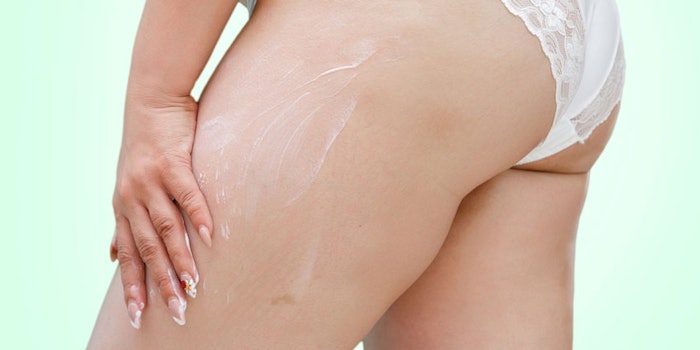
Many of us have experienced an unanticipated side effect of COVID-19: 'The Quarantine 15'—i.e., extra weight gain due to stay-at-home sheltering (with close access to food), and reduced access to fitness centers, socialized physical activities, etc.
This aligns with MarketWatch's projection that the global cellulite treatment market, including topicals, non-invasive and minimally invasive treatments, will see a CAGR of 5.5% from 2020 to 2025 to reach US $757.5 million (up from $611.9 million in 2019). It may also be one reason why we've seen the search term cellulite gain popularity on CosmeticsandToiletries.com. In relation, we offer the following brief review of recent anti-cellulite R&D in the literature.
Microneedle-delivered Herbal Anti-cellulite Actives
Amer, R.I., El-Osaily, G.H., Bakr, R.O., El Dine, R.S. and Fayex, A.M.; Scientific Reports; available at: https://www.nature.com/articles/s41598-020-63271-6
In this study, safe, efficient and painless 3D printed polymeric microneedles (MNs) were assessed for their capability to enhance the penetration of anti-cellulite actives through the skin. Upon application, the needles release their payload and dissolve. The present work was conducted in an animal model utilizing standardized Vitex agnus-castus and Tamarindus indica extracts.
Results indicated the extracts normalized the oxidative state and alleviated inflammation (TNF-α ~26% and 36%, respectively; MPO, ~26.3% and 57.7%, respectively; and adiponectin, ~50% and 70%, respectively). The authors concluded the transdermal delivery of T. indica, in particular, may help to ameliorate the appearance of cellulite. Furthermore, microneedles offer a simple, fast and relatively inexpensive solution for topical delivery.
Anti-cellulite Overview: Manifestation, Evaluation, Treatment and More
Abosabaa, S.A., Arafa, M.G. and ElMeshad, A.N.; Journal of Drug Delivery and Technology; available at: https://www.sciencedirect.com/science/article/abs/pii/S1773224720313733
This article gives an overview of all aspects related to cellulite. Approaches for reducing the appearance of cellulite, ranging from conventional physical and mechanical strategies, to oral and topical actives, are reviewed. Two carrier-based systems are considered: lipid and polymer-based carriers. Furthermore, methylxanthines, especially caffeine, are evaluated for lipolytic effects. The authors highlight how the main challenge of this active moiety is its inability to penetrate the stratum corneum, and they project this category is "a golden opportunistic research area to be exploited and developed."
Continuous Vibrational Massage to Mitigate the Appearance of Cellulite
Sadowski, T., Bielfeldt, S., Wilhelm, K.-P., Sukopp, S. and Gordon, C.; Intl J Cos Sci; available at: https://www.ncbi.nlm.nih.gov/pmc/articles/PMC7317706/
This work sought to evaluate changes in volume and the visible appearance of cellulite after the application of a hand-held, localized vibrational device over the course of 24 weeks. Effects were measured instrumentally and through subjective questionnaires in 40 healthy female volunteers. Subjects used the device for an 12 weeks, then were split into groups to measure any regression vs. the effects of continuous application. Cellulite in the regression subgroup returned to initial values soon after cessation of treatment, whereas cellulite remained diminished with continued use.
Anti-cellulite is 'a golden opportunistic research area to be exploited and developed.'
Nelumbo Nucifera (Lotus) to Promote Lipolysis, Slimming and Smoothing Effects in Skin
U.S. Pat 10806693B2; Publication date: Oct. 20, 2020; Assignee: ISP Investments LLC; available at: https://patents.google.com/patent/US10806693B2/en
This patent disclosure from ISP describes a cosmetic method for promoting lipolysis, slimming, draining and smoothing effects in skin by reducing the volume of localized fat deposits. These effects are achieved via the topical application of a composition including a Nelumbo nucifera (lotus) extract at 0.2% to 1.0% w/w. Said extract is obtained from the whole plant and has a dry matter ranging from 6.59-6.78% w/w; total soluble sugars ranging from 2.29-2.54% w/w; and total phenolic compounds ranging from 1.33-1.58% w/w. The composition is delivered in a dermatologically acceptable carrier, and reportedly demonstrates efficacy upon twice daily application.
Prostacyclin Receptor Agonists to Activate Lipolysis
U.S. Pat Application 20200171026; Publication date: June 4, 2020; Assignee: Allergan, Inc.; available at: https://www.freepatentsonline.com/y2020/0171026.html
Discussed in this Allergan patent application is an approach to activate lipolytic activity in adipocytes using prostacyclin (PGI2) analogues that are prostacyclin receptor agonists. These can be used to reduce subcutaneous adipose tissue and treat or reduce symptoms of obesity-related diseases or disorders for both cosmetic and therapeutic effects. Specifically disclosed for topical application are PGI2 receptor agonists selected from the group consisting of: selexipag, FK-788, beraprost, iloprost, carbacyclin, cicaprost and treprostinil, or a pharmaceutically acceptable salt thereof.
Sugar Apple, Rosemary and Prickly Ash Body Slimming
U.S. Pat Application 20200222304; Publication date: July 16, 2020; Assignee: Unigen, Inc.; available at: https://www.freepatentsonline.com/y2020/0222304.html
Finally, a patent application from Unigen Inc. provides methods for conditioning, firming, tightening or toning skin to address conditions related to cellulite, obesity, aging, etc. This is achieved through the topical application of an invention including one or more acetogenins, optionally combined with one or more isoquinoline alkaloids (e.g., aporphine alkaloids), and one or more terpenoids (such as phenolic diterpinoids).
More specifically, acetogenins such as squamocin and motrilin may be isolated from an Annona (sugar apple) extract; isoquinoline alkaloids such as magnoflorine and lauriflorine may be isolated from a Zanthoxylum (prickly ash) extract; and terpenoids such as carnosic acid may be isolated from a Rosmarinus or Salvia extract. The authors report this combination unexpectedly and synergistically increases the inhibition of lipid accumulation and intracellular triglyceride accumulation. It also improves cardiovascular function via a vasorelaxtion effect and the inhibition of platelet aggregation. Furthermore, it exhibits antioxidant functions.










